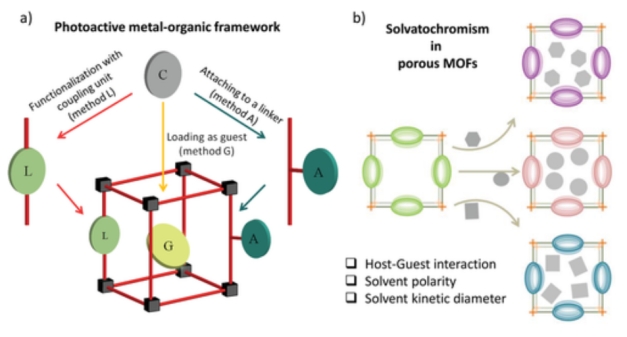In recent years, a particularly attractive and novel strategy has become available for the fabrication of photoresponsive, porous, and crystalline molecular solids from appropriately functionalized chromophoric linkers. The crystallinity of these materials allows a rather straightforward description and analysis using theoretical methods, thus tremendously accelerating the design of novel materials. This new class of crystalline molecular solids is referred to as metal–organic frameworks, MOFs (or porous coordination polymers, PCPs).MOFs are constructed from metal‐/metal‐oxo nodes and organic linkers (Figure 1). The incorporation of photoactive species into MOFs may be realized by using them as linkers (method L) or attaching them to a linker (method A), as shown in Figure 1a. In addition, the porosity of MOFs allows the loading of chromophoric compounds as guests (method G) into the pores of this interesting framework material. 
Figure 1
a) A schematic representation of different ways to integrate photoactive components in a metal–organic framework (MOF); b) schematic of a guest (solvent)mediated optical changes in porous MOFs, described as solvatochromism. It is important to note that in the context of photoresponsive behavior, MOFs carry a potential which by far exceeds that of nonporous coordination polymers. This is because simple loading of guest/solvent molecules of different size/polarity/functionality in the MOF pores can impart a large optical response, which is useful, e.g., for sensing applications.As an example, the solvent‐dependent optical response or solvatochromism is illustrated in Figure 1b. Such effects cannot be realized for nonporous coordination polymers.
References: https://www.moftechnologies.com/ https://onlinelibrary.wiley.com/doi/full/10.1002/marc.201700239 https://onlinelibrary.wiley.com/doi/10.1002/adma.201905227 https://systems.enpress-publisher.com/index.php/CAN/article/view/551 |


_1.jpg)
